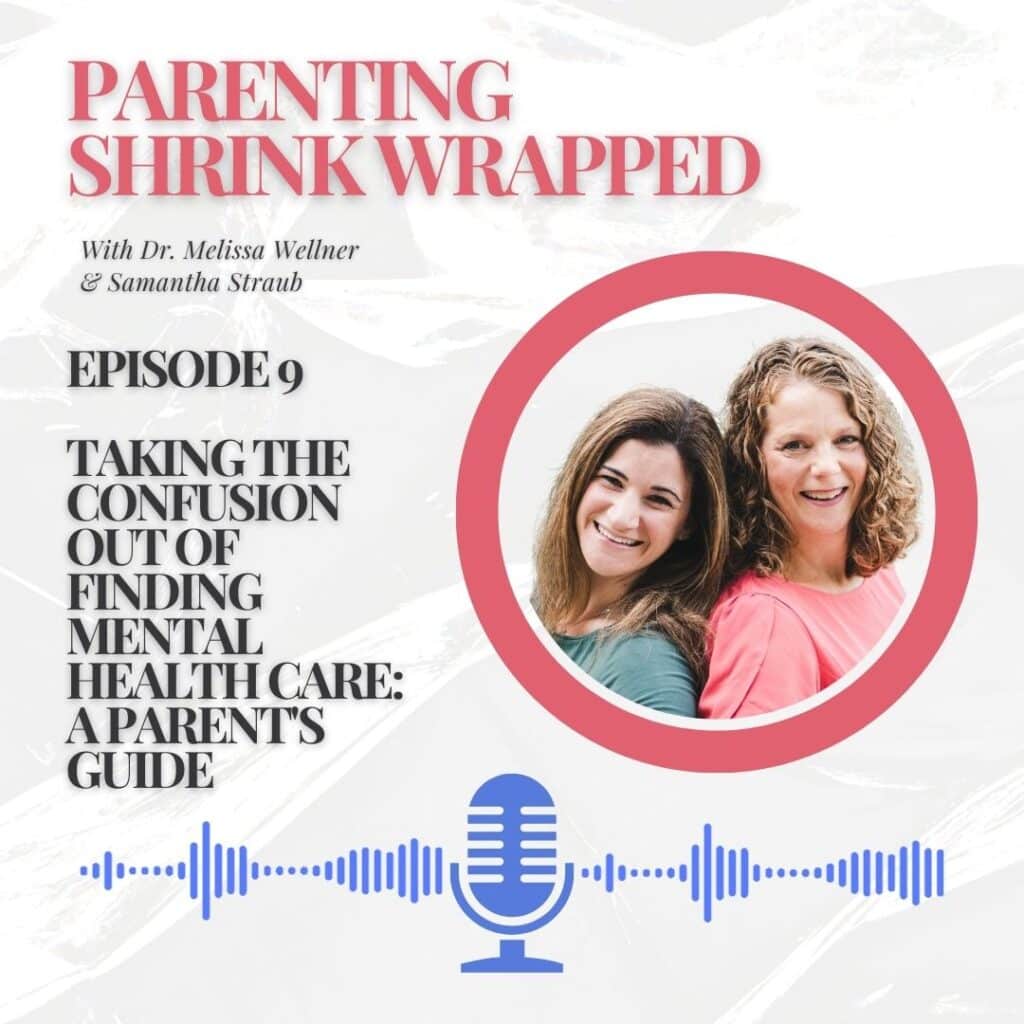A Parent’s Guide to Navigating Mental Health Care for Kids and Teens
Finding the right mental health care for your child or teen can feel overwhelming. With so many different professionals, options, and systems to navigate, it’s no wonder parents feel lost. But the good news? You don’t have to figure it all out on your own.
In a recent episode of Parenting Shrink Wrapped, Dr. Melissa Wellner and I broke down everything parents need to know about accessing mental health care. Here’s a helpful guide to get you started.
Step 1: Understand the Different Roles in Mental Health Care
Knowing who does what is the first step in finding the right support for your child. Here’s a quick breakdown:
- Pediatricians: Your first line of defense. They can provide basic mental health support and referrals to specialists. They can also prescribe medications, usually for more straight-forward mental health concerns such as depression, anxiety, or ADHD.
- Child and Adolescent Psychiatrists: Medical doctors who can prescribe medication and provide therapy. They receive extensive training, often with over 20,000 hours of clinical experience.
- Psychiatric Nurse Practitioners: Qualified to prescribe medication but with less training than psychiatrists. They’re often more affordable and accessible.
- Therapists and Counselors: Focus on delivering therapy sessions. They are trained to help children and teens develop coping skills and manage emotions.
- Social Workers: Like counselors, social workers also provide therapy. Their graduate training programs might have had a particular focus in systemic issues, such as family and community dynamics.
- Psychologists: Doctoral-level professionals who provide therapy and can conduct psychoeducational testing to identify learning or developmental challenges.
Step 2: Decide Between Telehealth and In-Person Therapy
Telehealth has expanded access to mental health care, but it’s not right for everyone. Here’s how to decide:
- Telehealth Benefits: Convenient, accessible, and ideal for ongoing therapy when in-person visits are difficult. Even with Telehealth, however, it’s often necessary for patients to see an in-state provider thanks to current licensing laws.
- In-Person Benefits: Better for establishing a connection with a new therapist or for teens who struggle to engage on video calls.
Ask your child which option they feel most comfortable with, as this can greatly impact their therapy experience.
O
Step 3: Explore Insurance and Payment Options
Understanding how mental health care is paid for can save you time and money.
- In-Network Providers: Covered by insurance but may have limited availability.
- Out-of-Network Providers: Often more accessible but require out-of-pocket payment. Many insurance plans allow you to submit claims for partial reimbursement. Ask your out-of-network provider to generate a “super bill” you can submit to your insurance company for reimbursement benefits.
- Community Resources: Some school counselors, pediatricians, or local organizations may provide referrals for free or low-cost services.
Step 4: Find the Right Fit
Therapy is most effective when there’s a strong fit between the therapist and your child. Fit includes:
- Comfort Level: Your child should feel safe and understood by their therapist.
- Expertise: The therapist should specialize in the areas your child needs support in (e.g., anxiety, trauma, chronic illness).
- Personal Preferences: Gender, age, and other factors can impact your child’s comfort level.
Don’t hesitate to ask questions or try a few initial sessions with different therapists to find the right match. If, after 3-4 sessions the chemistry doesn’t seem to be there, it might be time search for another provider. Patient-provider rapport is a key driver behind positive therapeutic outcomes.
Step 5: Use Trusted Resources to Find a Therapist
Here are some of the best ways to start your search:
- Psychology Today Directory: A searchable database of therapists by location, specialty, and insurance. Note that not all providers are listed here, as providers have to pay to have their name in this directory.
- School Counselors: Often have a list of local mental health providers.
- Parenting Groups: Word-of-mouth recommendations from other parents can be invaluable.
- Pediatricians: Can provide trusted referrals based on your child’s needs.
Final Thoughts
Navigating mental health care for kids and teens can be daunting, but you don’t have to go it alone. By understanding the different types of providers, deciding on the best format, and focusing on finding the right fit, you can take meaningful steps toward getting your child the support they need.
For a deeper dive into these topics, check out our podcast episode: Taking the Confusion out of Finding Mental Health Care: A Parent’s Guide.

Need more personalized guidance? At Teen Savvy Coaching, I specialize in supporting parents like you. You can schedule a single session with me to discuss best options for finding your teen the right support.







 Understanding Child and Adolescent Anxiety: When to Worry
Understanding Child and Adolescent Anxiety: When to Worry
Leave a Reply